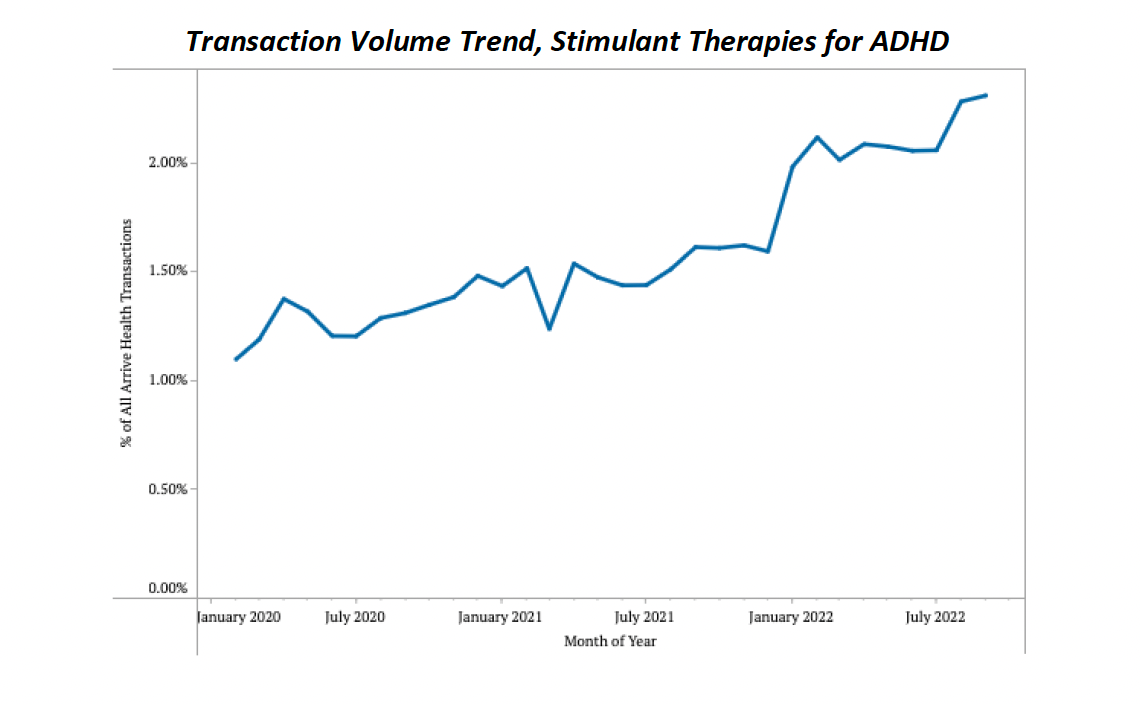Demand Up, Supply Down = Adderall Shortage
Short-term manufacturing problems are happening as the demand for Adderall and other stimulant medications for ADHD have increased. Data from Arrive Health show a marked increase in ADHD medication prescriptions for people in their 30s.
Adderall, one of the main drugs used to treat attention deficit hyperactivity disorder (ADHD), is increasingly short supply as demand increases and some manufacturers struggle with producing the drug.
There have been media reports of shortages for months, but the FDA officially declared that that there was a shortage of immediate release formulations of the drug on Oct. 12.
Teva Pharmaceutical Industries, one of the main manufacturers, has been hit by labor shortages, according to several news sources, and the FDA announcement mentioned that the company is “experiencing ongoing intermittent manufacturing delays.”
The website where the FDA lists drug shortages says today that the amphetamine salts — Adderall is a combination of a number of amphetamine salts — are “currently in shortage.” However, the company-by-company information dates from mid- to late October so it is not clear how current the information is. Three of the eight companies listed showed at least some of formulations of their amphetamine salt products as back ordered or having “supply constraints.”
Apart from the supply issues, the demand for Adderall and other drugs for ADHD has been surging for years. In 2018, Brian J. Piper, Ph.D., M.S., an assistant professor of neuroscience at the Geisinger Commonwealth School of Medicine in Scranton, Pennsylvania, and colleagues reported research results in Plos One that showed amphetamine use more than doubled from 2006 to 2016.
Researchers and others are just now getting a handle on how the COVID-19 pandemic has affected the demand for ADHD medications and Adderall more particularly. One of the main questions is whether telehealth companies such as Cerebral that specialize in mental health have led to overprescribing of medications for ADHD and possibly other conditions. The Department of Justice and the Federal Trade Commission are investigating Cerebral, and its CEO stepped earlier this year.
In June, Trilliant Health, a healthcare data analytics company, issued a report that showed suggested some interesting cross currents. Trilliant’s data showed Adderall prescriptions for children and young adults falling to pre-pandemic levels since the end of 2020. Meanwhile, prescriptions for people ages 22 to 44 went up 15% between 2020 and 2021. There was a slight increase in prescriptions among people 45 and older, according to Trilliant’s calculations.
Adam Rosenberg, Arrive Health

Arrive Health has also been analyzing trends in drug prescriptions. Headquartered in Denver, the company links electronic health records to the formularies of pharmacy benefit managers (PBMs) with the goal of making coverage and cost information available to the prescriber and patient as the prescription is being written. “We are the connection point between doctor’s e-prescribing workflow and the PBM,” Adam Rosenberg, the company’s senior director of marketing, said in a recent interview with Managed Healthcare Executive®. Rosenberg said Arrive has prescription data on between 150 million and 200 million people in the U.S. He emphasized that Arrive Health’s data is based on prescriptions that have been written — “pended prescriptions” — and that other companies and entitles would have data about the prescriptions that had been filled.
In early 2020, Arrive Health’s data show an uptick in prescriptions for many different types of medications, he said. “There were huge spikes in pending medication orders at the beginning of the (COVID-19) pandemic, across all drugs. And that was because patients were afraid to go to their doctors, so they were calling in as many orders (as they could ) or they were ordering large quantities.”
Stimulant prescriptions for ADHD (Arrive Health doesn’t have data yet on Adderall and particularly types of ADHD medications) were part of that initial increase but then rose slowly through 2020 and 2021 before soaring again at the beginning of this year, Rosenberg said.
Arrive Health’s data show that almost 2.5 million — approximately 18%— of the 14 million prescription for mental health and behavioral health medications between Feb. 1, 2020, and Sept. 30, 2022, were for stimulant medication for ADHD.
Arrive Health data from a spike in prescriptions for ADHD medications starting in January of this year.

“Antianxiety agents — no significant increases, actually slight decreases over the past two years,” said Rosenberg. “Antidepressants, similar, mostly (a) straight (trend). Antipsychotics are mostly straight. The ADHD meds are really the only one that has seen consistently increased trend.”
Arrive Health’s data also show a notable increase of prescriptions of ADHD drugs for people ages 30 to 39. Between January 2020 and September 2022, the proportion of pended prescriptions for ADHD drugs in that age group relative to all pended prescriptions increased from 2.4% to 5.5%.
Rosenberg shared some of the prevailing beliefs about the rising number of ADHD medications, namely, that more people are working from home and therefore getting prescriptions to cope with the distractions that come with working at home.
He also pointed to the growing awareness of mental health.
“There’s a trend to discuss mental health and mental health awareness with professionals — with your doctors, with an internist, with a psychiatrist,” Rosenberg said. “I think as people are more aware of what is going on in their own minds, they’re able to identify that they may need help and maybe looking to medication.”
How Magellan’s Behavior Health Program Saved up to $4,300 PMPY
November 7th 2023Using an AI platform, Magellan Health was able to better support providers in prescribing behavioral health medications and addressing medication problems, which reduced pharmacy costs and increased adherence.
Read More